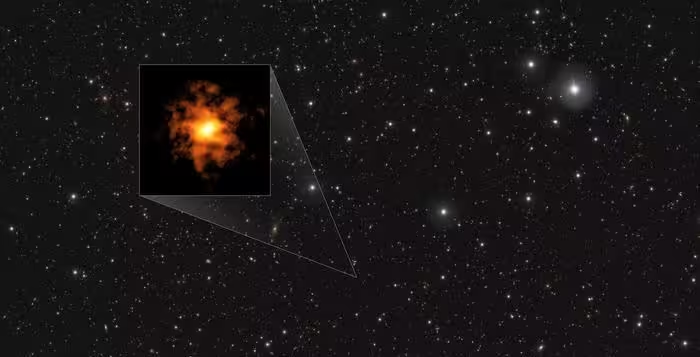Astronomers found a galaxy similar to the Milky Way
- October 9, 2024
- 0
One of the oldest galaxies in the universe has left scientists in a quandary: They didn’t expect to see anything like it just a few hundred million years
One of the oldest galaxies in the universe has left scientists in a quandary: They didn’t expect to see anything like it just a few hundred million years

One of the oldest galaxies in the universe has left scientists in a quandary: They didn’t expect to see anything like it just a few hundred million years after the Big Bang. An image obtained by the famous ALMA observatory (Atacama Large Millimeter/submillimeter Array), a radio telescope complex located in Chile’s Atacama desert, has become a new mystery for cosmologists. With its help, it was possible to study the mysterious galaxy REBELS-25.
It is so far away that astronomers are talking about time, not distance, in such cases. It is estimated that the observatory captured this galaxy as it was 700 million years after the Big Bang. This surprised scientists.
According to the currently accepted scenario of the evolution of the universe, about 380,000 years after the Big Bang, the first atoms appeared, space was filled with solid hydrogen “smoke”, and then for hundreds of millions of years the universe was plunged into darkness: there were no stars yet, hydrogen clouds blocked residual radiation. somehow it sucked. As they began to emerge, their light began to remove electrons from the surrounding hydrogen atoms, i.e., ionizing them.
This process was called reionization or reionization: Hydrogen first appeared as ions – single protons, then combined with electrons to form full-fledged atoms, and the first starlight reionized them.
It was previously thought that the era of reionization began approximately 550 million years after the Big Bang and continued for another 250 million years. Astronomers assumed at that time that there could only be “seeds” of future galaxies in the universe – their nascent cores, actively absorbing more and more matter, merging with other protogalaxies and often quite chaotic.
REBELS-25, meanwhile, is a disk galaxy with spiral arms that are already perfectly formed and ordered. At most, there are hints that, like the Milky Way, there is something called a bridge (“rod”) at its center.
According to estimates, the mass of the galaxy is eight billion solar masses and its diameter reaches approximately 13 thousand light years. Of course, compared to our Galaxy, this is not so much: the diameter of the Milky Way is about 100 thousand light years, and its mass, according to various estimates, reaches hundreds of billions or even trillions of masses of the Sun. However, for such a young galaxy, REBELS-25’s dimensions are simply incredible and its similarities to the Milky Way are striking.
This adds to the current picture of misunderstanding of the early history of the universe: the James Webb telescope had previously found an entire collection of galaxies that existed 300-400 million years after the Big Bang.
According to the currently accepted scenario of the evolution of the universe, the first atoms appeared approximately 380 thousand years after the Big Bang, the space solid was filled with hydrogen “smoke”, and then the universe was plunged into darkness for hundreds of millions of years. : There were no stars yet, and hydrogen clouds effectively absorbed the residual radiation. As they began to emerge, their light began to remove electrons from the surrounding hydrogen atoms, i.e., ionizing them. This process was called reionization or reionization: Hydrogen first appeared as ions – single protons, then they combined with electrons, forming complete atoms, and the first starlight reionized them.
It was previously thought that the era of reionization began approximately 550 million years after the Big Bang and continued for another 250 million years. Astronomers assumed at that time that there could only be “seeds” of future galaxies in the universe: their nascent cores, actively absorbing more and more matter, merging with other protogalaxies and often quite chaotic.
Meanwhile, REBELS-25 is already a well-formed, regular disk galaxy with spiral arms. Moreover, there are hints that at its center there is a bridge (“rod”), as in the Milky Way. According to estimates, the mass of the galaxy is eight billion solar masses and its diameter reaches approximately 13 thousand light years. Of course, it is small compared to our galaxy: the diameter of the Milky Way is about 100 thousand light-years, and its mass, according to various estimates, reaches hundreds of billions or even trillions of the mass of the Sun. However, for such a young galaxy, REBELS-25’s dimensions are simply incredible and its similarities to the Milky Way are striking.
This adds to the current picture of misunderstanding of the early history of the universe: the James Webb telescope had previously found an entire collection of galaxies that existed 300-400 million years after the Big Bang.
Source: Port Altele
As an experienced journalist and author, Mary has been reporting on the latest news and trends for over 5 years. With a passion for uncovering the stories behind the headlines, Mary has earned a reputation as a trusted voice in the world of journalism. Her writing style is insightful, engaging and thought-provoking, as she takes a deep dive into the most pressing issues of our time.